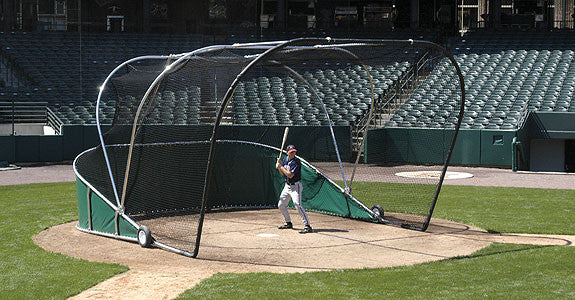Running Lane and Interference
The batter is out if, in running to first base, the batter-runner is hit by a throw while running outside of the 3 foot running lane, or interferes with the fielder taking the throw at first base. He could be called out even if he is not hit by the throw, if the umpire judges that by being outside the lane he interfered with the fielder’s attempt to field the throw. There must be a throw before interference can be called and the throw must be a quality throw. Rule 6.05(k).
A runner is not free from interference while in the lane, nor automatically guilty when out of the lane. If he is out of the lane he is in serious jeopardy of being called for interference, but it is not automatic, unless he is hit by the throw, or commits an intentional act of interference. The rule states that he is out when out of the lane AND causes interference with the fielder taking the throw. If he is out of the lane and is hit by the throw, that is always interference. If he is in the lane he could still cause interference, but it would have to be something obviously intentional (like grabbing the fielder's arm or glove, or deliberately touching a thrown ball). If the catcher does not make a throw because the runner is outside the lane, this is not interference. Interference with a thrown ball must be intentional. Such as, deliberately making contact with it. Or in this case if the runner is hit by the throw while outside the lane. The lines marking the lane are part of that "lane," but the runner must have both feet within the lane or on the lines marking the lane, to be judged as "in" the lane. Rule 7.09(k) casebook, N.A.P.B.L 4.14.
If the runner is hit by the throw or a collision occurs on his last step before touching the base; generally interference is not called. The runner has to step into fair territory to touch the base that is in fair territory.
-
You must tag the base with your foot on a force out or appeal.
You may tag the base with any part of the body or glove as long as you have firm and secure possession of the baseball in your hand or glove/mitt.
-
The ball is always immediately dead on a balk.
You are correct in high school baseball but in NCAA and professional rules, the ball is dead sometimes immediately but when the balk is followed immediately by a pitch, the ball is delayed dead and we wait until the end of the play and then either enforce the balk or allow the play to stand. If all base runners, including the batter-runner advance one base or more after the balk, the play stands. The coach or manager does not have an option on this rule.
-
If a player's feet are in fair territory when the ball is touched, it is a fair ball.
It is the location of the baseball when it is touched or touches the ground that determines it being fair or foul and not the position of the fielder’s feet.
-
The ball must always be returned to the pitcher before an appeal can be made.
If the ball is live, you may go directly to the missed base or the runner and tag him for missing the base or leaving it too soon on a fly ball that is caught.
-
With no runners on base, it is a ball if the pitcher starts his windup and then stops.
For a balk to be awarded, there needs to be runners because the penalty is 1 base awarded.
- The pitcher must come to a set position before a pick-off throw.
The pitcher need only come to a complete and discernible stop prior to pitching the ball and not for a pick off attempt.
-
The pitcher must step off the rubber before a pick-off throw.
In fact, if he does step off first and the ball is thrown away into dead-ball territory, the award is 2 bases. From the rubber, it is only a 1 base award.
- If a fielder catches a fly ball and then falls over the fence it is a home run.
If the catch occurs before leaving the field of play it is a catch and not a home run.
-
The ball is dead anytime an umpire is hit by the ball.
This is only true on a batted ball that the ball is dead. On a thrown or pitched ball, it is unfortunate but the ball remains live.
-
The home plate umpire can overrule the other umps at anytime.
The home plate umpire has no more right to overrule his partner(s) than they have to overrule him. In certain situations the UIC may have to change a call because of more correct information but no umpire has the right to overrule another.
Umpire question if you please: we were playing a high school game on Friday and we had a situation that seems to be contradicting in how the umpire awarded the bases. Here's the first situation the pitcher had a wild pitch go off of the catchers shin guards and go into the dugout. The umpire only awarded one base the runner at first. Then as circumstances would happen there was a runner at first a couple of innings later and the picture try to pick him off and threw it out of play over the fence. This time the umpire awarded the runner all the way to third. I don't see the difference really.
Answer to Coach
I believe the umpire was right because of the rule that governs the pitcher and overthrows. When a picture is in contact with the rubber ball that he throws as a pitcher no matter where he throws is only awarded one base on overthrow out of play. What I think you left out of the description of the play to first base is, that the pitcher stepped off the rubber and threw it out and play. When he stepped off the rubber he became the infielder the rule for infielders outfielders is two bases at the time throw are awarded. Therefore he was infielder, the runner possessed first base, so he was awarded two bases on the overthrow out of play and ended up at third base. So I believe that's what happened in the umpire was correct.
UmpireI was watching my son's game last night at the high school level. I saw something during the game that caused me confusion, can you straighten me out as to what and when a batter can run a dropped 3rd strike.
Fred
==========================
Fred
you are not alone a lot of people are confused including the players on this situation. There are a couple situations when the batter can or cannot run after dropped third strike.
1. He can always run after dropped third strike if there is no one on first base.
2. Cannot run I dropped third strike if there are less than two outs and first base is occupied.
3. This one is the one that seems to cause most confusion if there are two outs and regardless if first base is occupied or not a batter can run on a dropped third strike.
Note to go along with the question. The catcher need to know not to make a play on a runner that takes off to first with first occupied and less than 2 out. The umpire will help but it is his responsiblity to know not to throw. Then with 2 outs and the runner moving to first that batter/runner must be put out OR they can put out any runner that is in a force play situation. It does not have to be the batter/runner that is played on for the 3rd out.
Hope this helps.
Ump Arnald Swift
Hey Ump, I have another question. If the batter hits the ball down the first baseline & the 1st baseman fields the ball in front of the bag with one foot in fair & the foot in foul territory,is the ball fair or foul?
Answer:
I really can't answer your question because the player has nothing to do with whether the ball is fair or foul. In the baseball what determines if a ball is fair or foul is where it's located when touched by a player. If the ball is on or over line when touched then the ball is fair regardless of where the player is. It is quite conceivable to have a player in fair territory when he touches the ball, but the ball is located outside of the line, therefore it is foul. To expand on this little bit a ball that is it and touches the ground in front of first or third base then passes over or inside of the base is fair regardless of where it touches after it passes the base. If the ball is in flight when it goes past first or third in what determines it to be fair or foul is where it lands or is first touched by a player. Therefore the reason I couldn't answer your question directly is you didn't tell me where the ball was when touch, and the player position has nothing to do with determining fair or foul.










